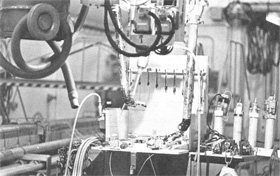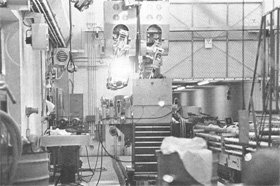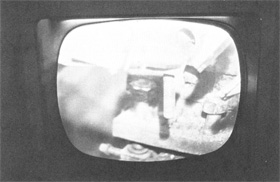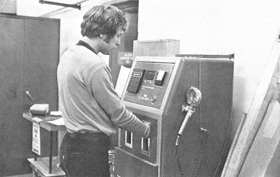Bionic Arms Salvage Neutrino Train
"Bionic" arms, Fermilab's version, are helping salvage a train "wreck" in the Neutrino Area.
The arms are servo-manipulators, electromechanical creations that perform the functions of arms, hands and fingers with human direction. Fermilab Neutrino engineers are employing the bionic arms to clean up a disabled neutrino target train. A modified mine locomotive hauls beam line equipment into the target tube on narrow-gauge (30 in.) tracks laid in the complex--including the target tube, target hall (Neuhall) and target service building.
According to Jack Lindberg, associate mechanical group leader, the salvage story started in December. The Proton Area went into standby Dec. 20 to allow high intensity beam running to the Neutrino Area. During the morning of Wednesday, Dec. 29, all beam was shut off to the Neutrino Area--three experiments reported 80-90 percent decrease in triggers, E310, E482 and E460.
"Something in the beam," Shigeki Mori, mechanical group leader said, "was stopping secondary particles which decay into neutrinos. Everybody was puzzled; no one knew what the problem was."
They found out by looking into the target tube with a 60X telescope. The view revealed that an eight-foot long steel collimator--a device for collimating secondary particles-had been heated to about 1500°F by the particles during the high intensity run.
As a result, the assembly of a series of two-inch steel slabs, measuring 6 x 6 inches, had begun to soften. When it couldn't support its own weight, the collimator sagged into the beam, becoming a sponge for neutrinos. Richard Lundy, associate section leader, credited the collimator with nobly doing its job of protecting the downstream magnet.
Only shreds remained of the collimator's aluminum cover.
No one expected secondary particles to deposit that much thermal energy, and as a result the area received significant radiation contamination, requiring a four-day cleanup project conducted by Radiation Physics personnel. Fred Gardner, radiation safety officer supervised procedures.
Repairs got underway after New Year's. The disabled triplet was pulled from the target tube and stored for reconstruction. A horn train was inserted in mid-January.
Rejuvenation of the triplet, due to high radioactivity of the equipment, was done remotely in the target service building. Enter Fermilab's bionic arms!
"Main purpose of the system," John Simon, remote systems engineer said, "is to minimize, if not totally eliminate, radiation exposure to personnel."
Argonne Mark IV Electric Master-Slave Manipulator Installation is the technical name. It, and a 20-ton crane, are mounted on separate overhead bridges and operate on the same set of rails. Two closed-circuit TV cameras, equipped with zoom lenses and pan and tilt supports, are mounted at opposite corners of the building.
The manipulators were prototypes developed by the Remote Control Division of Argonne National Laboratory. Except for modernization of transistor servo-amplifiers, they are original equipment. The manipulator unit consists of a pair of slave servo-manipulator arms mounted on a bridge, carriage and rotating turret.
The arms move five feet, on a vertical post. They can reach about 85 percent of the floor area from the floor to about 10 feet high and approach most work from any angle.
The unit's eyes are two high-resolution TV cameras mounted under the body of the right-hand manipulator slave. One camera, with a zoom lens, provides a detail magnified view; the other, with a wide-angle lens, covers the entire area reached by the arms. A third TV camera, mounted facing down, gives a plan view of the tongs and operating area.
By late March work had progressed to the point where partial manual methods could be substituted. The repair unit's objective is to have the train completely revitalized by June, with help from Fermilab's "bionic arms."








